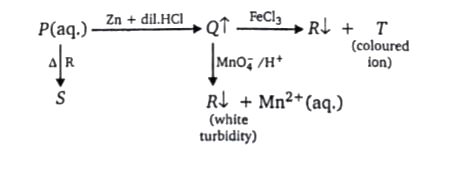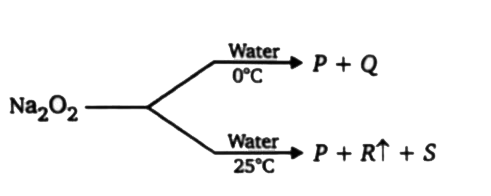XO+I2O5(s)→CO2+I2
For disproportionation reaction.
For comproportionation reaction.
For either intermolecular redox reaction or displacement reaction
For either thermal combination redox reaction or thermal decomposition redox reaction.
The correct Answer is:c
To determine the type of reaction represented by the equation CO+I2O5→CO2+I2, we can follow these steps:
Step 1: Identify the Reactants and Products
The reactants in this reaction are carbon monoxide (CO) and iodine pentoxide (I₂O₅). The products are carbon dioxide (CO₂) and iodine (I₂).
Step 2: Assign Oxidation States
Next, we need to assign oxidation states to each element in the reactants and products:
- For CO:
- Carbon (C) in CO has an oxidation state of +2 (since O is -2).
- For I₂O₅:
- Iodine (I) has an oxidation state of +5 (calculated as 2X + 5(-2) = 0, thus X = +5).
- Oxygen (O) has an oxidation state of -2.
- For CO₂:
- Carbon (C) in CO₂ has an oxidation state of +4 (since O is -2).
- For I₂:
- Iodine (I) in I₂ has an oxidation state of 0 (elemental state).
Step 3: Determine Changes in Oxidation States
Now we analyze the changes in oxidation states:
- Carbon (C) changes from +2 in CO to +4 in CO₂ (oxidation).
- Iodine (I) changes from +5 in I₂O₅ to 0 in I₂ (reduction).
Step 4: Classify the Reaction
Since we have one species being oxidized (C) and another being reduced (I), this reaction is classified as a redox (reduction-oxidation) reaction.
Step 5: Identify the Type of Redox Reaction
In this case, since two different reactant molecules (CO and I₂O₅) are involved in the redox process, it is classified as an intermolecular redox reaction. This is distinct from disproportionation or comproportionation reactions, where a single species is oxidized and reduced or where a single species is present in two different oxidation states, respectively.
Conclusion
The reaction CO+I2O5→CO2+I2 is an intermolecular redox reaction.
---
The reactants in this reaction are carbon monoxide (CO) and iodine pentoxide (I₂O₅). The products are carbon dioxide (CO₂) and iodine (I₂).
Next, we need to assign oxidation states to each element in the reactants and products:
- For CO:
- Carbon (C) in CO has an oxidation state of +2 (since O is -2).
- For I₂O₅:
- Iodine (I) has an oxidation state of +5 (calculated as 2X + 5(-2) = 0, thus X = +5).
- Oxygen (O) has an oxidation state of -2.
- For CO₂:
- Carbon (C) in CO₂ has an oxidation state of +4 (since O is -2).
- For I₂:
- Iodine (I) in I₂ has an oxidation state of 0 (elemental state).
Now we analyze the changes in oxidation states:
- Carbon (C) changes from +2 in CO to +4 in CO₂ (oxidation).
- Iodine (I) changes from +5 in I₂O₅ to 0 in I₂ (reduction).
Since we have one species being oxidized (C) and another being reduced (I), this reaction is classified as a redox (reduction-oxidation) reaction.
In this case, since two different reactant molecules (CO and I₂O₅) are involved in the redox process, it is classified as an intermolecular redox reaction. This is distinct from disproportionation or comproportionation reactions, where a single species is oxidized and reduced or where a single species is present in two different oxidation states, respectively.
The reaction CO+I2O5→CO2+I2 is an intermolecular redox reaction.
Topper's Solved these Questions
- TYPES OF REACTIONSBOOK - VK JAISWAL ENGLISHCHAPTER - TYPES OF REACTIONSEXERCISE - LEVEL 2
196 Videos
- TYPES OF REACTIONSBOOK - VK JAISWAL ENGLISHCHAPTER - TYPES OF REACTIONSEXERCISE - LEVEL 3
44 Videos
- s-BLOCK ELEMENTSBOOK - VK JAISWAL ENGLISHCHAPTER - s-BLOCK ELEMENTSEXERCISE - SUBJECTIVE PROBLEMS
2 Videos
Similar Questions
Which of the following metal nitrate produces gaseous product when reacts with KCN solution?
View Solution
Q. Species P and S are respectively:
View Solution
Calculate sum of bond order between same bonded atoms in Q and R compounds.
View SolutionEstimation of oxidising substance involving the liberation of I_(2) and subsequent volumetric estimation of I_(2) are refferred to as 2Cu^(2+)+4I^(Theta)rarr Cu_(2)I_(2)+I_(2) I_(2)S_(2)O_(3)^(2-)rarr S_(4)O_(6)^(2-)+2I^(Theta)
View SolutionThe percentage of oxygen in an organic compound can be determined by converting O of the compound quantitatively into (i) CO_(2) (ii) I_(2)O_(5) (iii) I_(2) (iv) CO
View SolutionI_(2)+S_(2)O_(3)^(2-) to
View SolutionFind relation in between current i_(1), i_(2), i_(3), i_(4), i_(5)" and "i_(6) .
View SolutionWhat is the use of O_(2)F_(2) and I_(2)O_(5) ?
View Solutionunderline(I_(2))O_(5)+H_(2)O to HIO_(3)
View SolutionXO+I_(2)O_(5)(s) to CO_(2)+I_(2)
View SolutionIn the balanced equation I2+xO3→I4O9+O2 the 'x' is
View Solution2 gm of a mixture of COandCO2 on reaction with excess of I2O5 produced 2.54 gm of I2. What will be the mass % of CO2 in the original mixture ?
View SolutionI2––O5+H2O→HIO3
View SolutionIf In=∫cotnxdx then I0+I1+2(I2+I3)+I4+I5=
View Solution(A) I2,CO2 have low melting point (R) I2,CO2 have weak dispersive attractive forces between molecules
View Solution
